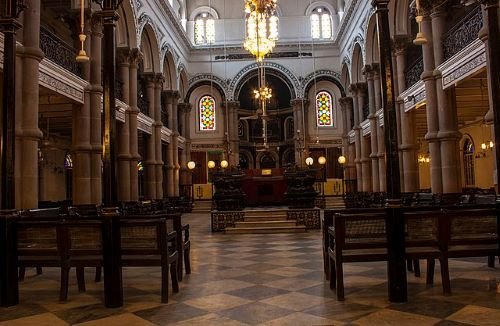Indian Cathedral Design With Exclusive And Stunning Social Vibes
A building would be more valuable if it stood on a foundation of faith and harmony. Indian cathedral design has the same tale.
Introduction
The Indian cathedral designs have a very high impact from the colonial era. Alternately, it’s a commendable mixture of the Western and Indigenous styles of architecture. Next, one can easily differentiate the influence of various sections; like French, British, Portuguese, or even Greek architectural styles in cathedral buildings.
The Indian subcontinent is native to the Hindus who practiced Hinduism since past ages. But, with the dawn of Christianity, the preachers and missionaries came down to this land. From the 1st century CE to the Indian independence, American and European powers engaged themselves with the Church proliferation in India. Hence, the Western shadow in construction styles converged with locally available materials in India. Also, in the last two millennia, India came under the rule of different dynasties and religions. Indian cathedral architecture has all tones and hues of this diversity.

The tolerant and inter-woven culture of the Indian subcontinent catalyzed church activities. Thus, the Gothic architecture by the Europeans flourished and was showcased in various colonial monuments. Say it, Baroque or Romanesque, all imported building styles have the cultural and material recess for Indian molding. So, the architectural fusion worked well for constructing cathedrals and churches in India. However, the ruling power at the time had a major stake.
Religious Harmony
All Saints Cathedral in Prayagraj is built with red sandstone and marble. In the same way, Saint Thomas Cathedral Basilica in Chennai used granite and marble during its construction in the 19th century.
The Indian cathedral designs had the support and influence of the contemporary rulers in the particular regions. Further, it engaged with the culture and traditions of the local populations. The peaceful blending thus, played a vital role in church progress on Indian soil, with almost no resistance. Alternatively, people used to move for blessings from bishops without religious bar. Not only that, but the local architects also learned a lot from the European and Romanesque design styles.
In particular, Indian Cathedral Designs are the authentic narratives of cultural and religious harmony. The palpable confluence of the two religions and cultural practices also gave birth to the Anglo-Indian living styles in India.
Historical Background and Evolution
Indian cathedral design over centuries, had various Western architectural imports. The Britishers who ruled for a long in India, systematically blended Indian arts into church throughout the nation. On the other hand, the Portuguese had a small, yet, considerable role in designing church buildings with Indigenous crafts and craftsmen. Significantly, after the American missionaries in the first century, the Europeans majorly impacted the Indian church in the colonial era.
The incredible church designs in India have become some UNESCO World Heritage Sites; for example, The Basilica of Bom Jesus in Goa. The Marvel is set in awesome stone carvings by local artisans, and, typical altars, of the Baroque architecture. Similarly, thin gold layering on its altar surface was a unique experience for the Portuguese.
Another beautiful construction was in Puducherry. French East India Company erected the. Interestingly, the Church of the Sacred Heart of Jesus is of the European style in India. Here, the local workers skillfully shaped flying buttresses. Also, they managed to mold the pointed spires with locally available materials. The city in southern India, Puducherry, exhibits many buildings today, with explicit French influence and Gothic revival architecture.
The British also contributed significantly. The paramount buildings like Saint Paul’s Cathedral, Kolkata, showcase Victorian architecture; a style, that gained momentum during the Industrial Revolution in Britain. Next, the techniques of building tall spires surfaced at the Kolkata cathedral. Further, it largely displays stained glass, and Indian stonework designs in its construction. So, this again, is an outcome of mutual mastery of the East and the West, in terms of technique, workmanship, and material selection.
Architectural heritage
No doubt, a drastic change occurred after Indian Independence. There are now new construction practices involved in Cathedral buildings. Yet, the historical and traditional credentials are firmly packaged into it. The interwoven tastes of the colonial shadows and the Indian craftsmanship have permanent marks on Indian cathedrals. For this reason, these structures have become architectural heritage in India.
Key Architectural Features
The cultural and religious diversity of Indian society helps a lot while designing a structure. Likewise, Indian Cathedral designs have a wide spectrum of ideas in this context. The European churches are limited to the Gothic or Romanesque styles and some of their variants. On the contrary, the Indian cathedrals selected styles from Hindu Temple architecture, Mughal architecture, and Dynastical architecture, and their appropriate mix versions.
The materials’ choice is mostly confined to their availability and budgetary to aesthetical values. However, tropical conditions play a big role in India. Historical monuments in India therefore, have the proper selection of materials leading to desired sustainability. Additionally, the Vastu-related ancient science provides maximum support in fighting global climate changes. The ancient Palatial buildings, for instance, have a proven record of this Indian architectural concept, Vastushastra.
What are rather, Indigenous architectural elements in India? The Indian cathedral designs cannot ignore stone carvings or scriptural myths for its edifice decoration. Moreover, the folklore and classical dance styles are like live depictions on the walls of the catholic church. Interestingly, The Nataraj Temple in southern India is, for instance, dedicated to the divine dance form. A unique landscape of universal elements like the sun, moon, and stars also became integral to churches, like temple architecture in India. Above all, it is an explicit design confluence of the Thames and Ganga. And, it reminds us of the golden era of the colonial time.
Design precision and mutual respect
It’s not that Western architecture hasn’t the eye-catching pillar designs or artistic glasswork. It’s not that those structures lack grandeur or divinity. Yet, the transactional culture produced outstanding designs with stained glass windows in Indian flavor.
The facades and roofs or ceilings are visible from outside of a structure. Hence, these architectural elements are true identifications of their particular design style. The beauty of the Indian cathedral designs comes from its simpler domes compared to Western ribbed vaults. However, the ornamental mosaic works by local artisans have a larger role in its beautification. Nevertheless, the overall appearance of churches in India is coated within Gothic revival architecture.
Characteristic Indian styles significantly involve beauty with utmost precision. Next, the architectural elements, such as paintings on fresh plasters are maintenance-free and long-lasting. The Indian craftsmen have mastered it with generations of constant practice. They have profound knowledge regarding the texture and minute shadows within such articles.
Mutual respect for Western and Indian architecture is a supreme reality. Otherwise, the intermingled design patterns would not ornate Indian cathedral design. So, unity despite diversity has become a prominent character of the east-west union in catholic church construction in India. Similarly, the Gothic pointed spires, above the native floral display on walls are an unparalleled combo.
Integration of Local Artistic Traditions
Structures in India, be it temples, churches, or a mosque; carry specific traditional flavor. Powerful rulers have left strong traditions; reflected in their respective monuments across the state. The Mughal Empire had a vivid landscape of incredible structures in the Indian subcontinent. Murals are an integral part of these historical Mughal monuments, which accordingly decorate the surfaces of the Indian church. Also, the same Mughal introduction of frescoes deliberately enhanced the beauty of the Indian cathedrals. Thus, the designs of the Indian catholic structures experienced a tri-confluence of Muslim, Christian, and Hindu efforts as a whole.
Indian cathedral designs used a much larger portion of Hindu temple styles and materials. Somewhere, the depiction of biblical myths, and in other places, the cathedrals worked with motifs. Moreover, the Indian craftsmanship offered pillars, ceilings, walls, and doors-windows with delicate carvings on different materials.
Stones have been the pervasive material in India. Therefore, the beauty and strength of marble and granite attracted the colonial organizers. Additionally, it provided a wide catalog of different shades to choose from. On the other hand, red sandstone was the material that was easy to handle and work with.
Kshatriya traditions in the western parts of India showed thrilling painting skills. The Rajputs or Kshatriyas, hold the edgy and aggressive trends of colors and patterns. The same Hindu temple architecture beautifully converged with European thoughts, which lent grandeur to the Indian cathedral designs. Eventually, like Hindu temples, the intricacy of the pillars and carvings became undeniable elements of cathedrals.
Significant Cathedrals in India
- Among several architectural pieces, splendid works in St. Thomas Cathedral stand apart. Just entering the campus, one feels a meditative atmosphere, because it is located in the heavy-traffic environment of Mumbai city. The structure, the oldest church in Mumbai, constructed 300 years back flatters the British colonial regime. It’s a typical Gothic structure. However, wooden carvings and windows in stained glass have Indian stamps on them. Furthering the neoclassical look, it is constructed with ribbed vaults and pointed arches. This is the Indian cathedral design that heralded the Anglican church in India.
- Another important church is the Gothic-styled St. Paul’s Cathedral. It harbors the historical value of the British colonial rule in India. Besides, it is a memorial for the founder of Kolkata city, the late Job Charnock. The spires like that of the ‘Victoria Tower’ in England, assign a gorgeous look to the biggest catholic shrine of Kolkata. Additionally, there is a vast congregation hall for the Christian devotees.
- The Basilica of Bom Jesus in Goa has reddish-brown facades. The laterite stone, used in the elevation walls, offered its natural color because it is sedimented with iron and aluminum elements. Moreover, there is a huge marble flooring inside the cathedral. Alternately, a gilded altar is another attractive subject in the church. And, the stunning designs are the brilliant works of the local craftsmen. People from all religions visit Bom Jesus. And, they witness the scientifically preserved dead body of St. Xavier who died in 1552 CE. The sacred building was built in 1605 during the Portuguese regime in Goa. Thus, the Indian Cathedral Design is a powerful symbol of the brotherhood between Christianity and the Indian people.
Modern Innovations in Cathedral Design
Rooted traditions imbibe more cultural aspects, but differently. The inventions and use of newer materials engrave new cultures in society. Besides, contemporary designs all over the world nowadays, seek more sustainable things. Accordingly, architects and builders prefer green building concepts for their upcoming projects.
In most new constructions, either a temple or a cathedral, rainwater harvesting gets the utmost importance. Secondly, the designers make all necessary provisions to use natural resources for light and air ventilation therein. The growing concerns about greenhouse emissions usher every intellectual to move for recycled and eco-friendly materials. So is the increasing idea of solar energy and wind power.
Indian cathedral designs adopt the contemporary Minimal Design creed creating some focal pins to enhance spirituality and aesthetics.

